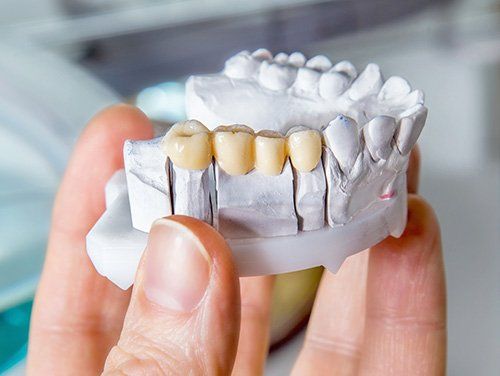The preparation for a bridge is much the same as the preparation for crowns. That’s because the two teeth on either side of the missing tooth will receive crowns. The difference with a bridge is it includes a porcelain or ceramic replacement tooth. If there is just one tooth missing, there will be one replacement tooth attached to two crowns. There could also be two or three replacement teeth in a row, requiring a longer bridge which is secured to the teeth on either side. More missing teeth than that would normally require a partial denture as a replacement.
When it has been verified that the teeth and gums in the area are healthy, and Dr. Murphy and the patient are both in agreement on the goals of treatment, the next step would be preparation of the two anchoring teeth. The crowns placed on these teeth may be referred to as abutments.
Just like when an individual crown is placed, the teeth must first be shaped to accept the abutments for the bridge. Some material will be trimmed from all sides and the top of these two teeth after the patient is numbed.
Then the exact dimensions of the final shape of these teeth must be recorded, which can be done by having the patient bite into a soft plastic mold or it can be done digitally with a special camera that fits into the mouth. The goal is an accurate representation of the space to be filled with the new bridge.
The specifications on the size of the two anchoring teeth, the opening created by the missing tooth and the person’s bite go to the lab so they can create the bridge out of ceramic or porcelain. In some cases, metal may be used as a foundation for this bridge to increase its longevity if it is likely to receive intense chewing or biting stresses.
After the dimensions are recorded, the patient will receive two temporary crowns to protect the anchoring teeth while the bridge is manufactured.
A week or two later, the patient will come back to have the bridge placed. This procedure will probably not require more numbing. First, the two temporary crowns which were fastened with a removable cement will be taken off. Then Dr. Murphy will carefully check the fit of the bridge and make any adjustments necessary to ensure a perfect fit. He may place the bridge and take it off several times as he makes these corrections.
When he is satisfied with the fit and both he and the patient are happy with the appearance of the bridge in the mouth, it will receive a final cementing. The permanent cement will be placed inside the two crowns and it will be fit onto the two anchoring teeth. After allowing it to sit for a few minutes, Dr. Murphy will clean away any excess cement and the procedure is done.
When you receive a new bridge, be sure you do not eat anything sticky for the first day so the cement under the bridge has a chance to bond fully.

